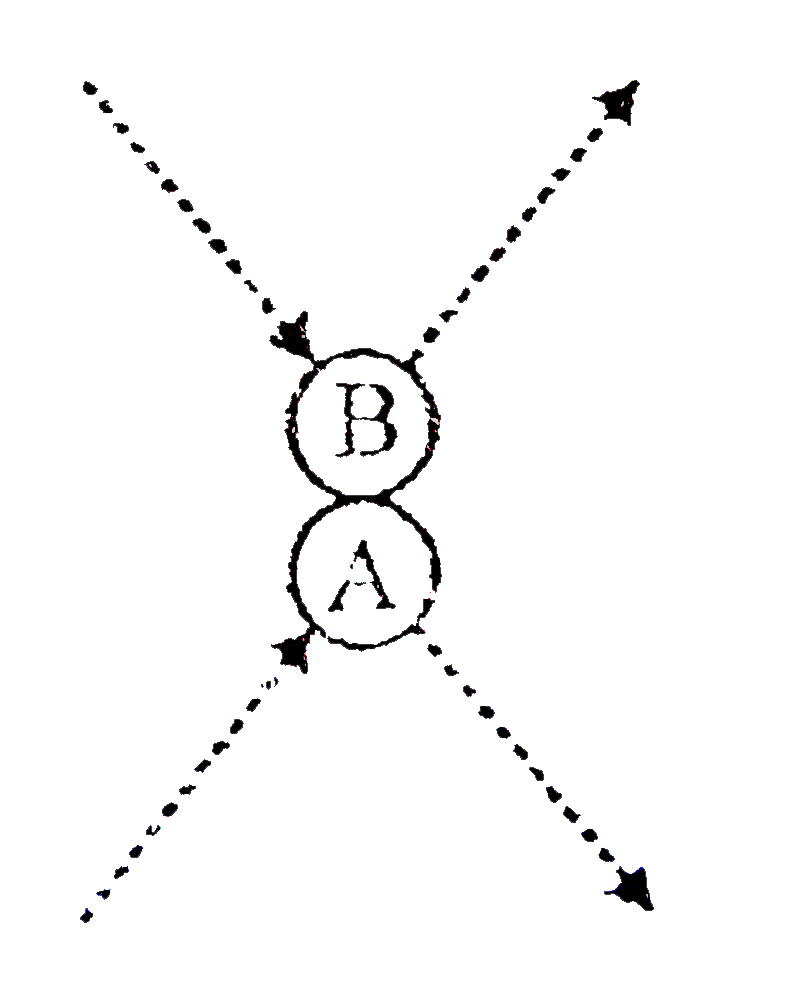The figure below shows three identical balls A , B and C. Initially , the baiis B and C are at rest and the ball A while moving with a veiocity v, collides with ball B. if the collision is perfectiy elastic , then after the collision

all the three balls move with velocity v2
A comes to rest and (B+C) moves with velocity v√2
A move with velocity v and (B+C) moves with velocity v
A and B comes to rest and C moves with velocity v
The correct Answer is:D
Step by step video & image solution for The figure below shows three identical balls A , B and C. Initially , the baiis B and C are at rest and the ball A while moving with a veiocity v, collides with ball B. if the collision is perfectiy elastic , then after the collision by Physics experts to help you in doubts & scoring excellent marks in Class 12 exams.
Updated on:21/07/2023Topper's Solved these Questions
Similar Questions
A ball of mass m moving with velocity v collides head on elastically with another identical ball moving with velocity - V. After collision
View SolutionThree identical balls 1, 2 and 3 are placed together at rest on a smooth horizontal surface. A fourth identical ball moving with velocity u in line of first three balls collides head on elastically as shown in figure, then

View Solution
Knowledge Check
STATEMENT - 1 : Two identical balls B and C lie on a horizontal smooth straight groove so that they are touching. A third identical ball A moves at a speed v along the groove. And collides with B as shown in figure. If the collisions are perfectly elastic, then after the collision, balls A and B will come to rest and ball C moves with velocity v to the right.
because

STATEMENT - 2 : In an elastic collision, linear momentum and kinetic energy are both conserved.AStatement - 1 is True, Statement - 2 is True, Statement - 2 is a correct explanation for Statement - 1.BStatement - 1 is True, Statement - 2 is True, Statement - 2 is NOT a correct explanation for statement - 1.CStatement - 1 is True, Statement - 2 is False.DStatement - 1 is False, Statement - 2 is True.Velocity of the ball A after collision with the ball B as shown in the figure is (Assume perfectly inelastic and head - on collision)
 A37m/sB57m/sC17m/sDZero
A37m/sB57m/sC17m/sDZeroConsider the elastic collision f two bodies A and B of equal mass. Initially B is at rest and A moves with velocity v. After the collision -
Athe body A tracks, its path back with the same speedBthe body A comes to rest and B moves aways in the direction of A' is approach with the velocity vCboth the bodies stick together and are restDB moves with velocity v/2 and A retraces its path with velocity v/2
A massive ball moving with speed v collides with a tiny ball by negligible mass. The collision is elastic. Find the speed with which the second tiny ball will move.
View SolutionA ball A of mass M collides elastically with a similar ball B at rest as shown in figure. Initially velocity of ball A is u m/s. After collision,

View SolutionSuppose a golf ball is hurled at a heavy bowling ball initially at rest and bounces elastically from the bowling ball after the collision
View SolutionA ball of mass m moving with velocity V, makes a head on elastic collision with a ball of the same moving with velocity 2V towards it. Taking direction of V as positive velocities of the two balls after collision are.
View SolutionThe figure below depicts the paths of two colliding steel balls, A and B. Which of the arrows 1−4 best represents the impulse applied to ball A during the collision?

View Solution
